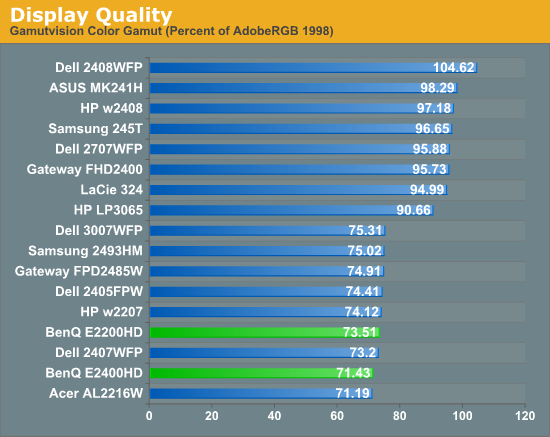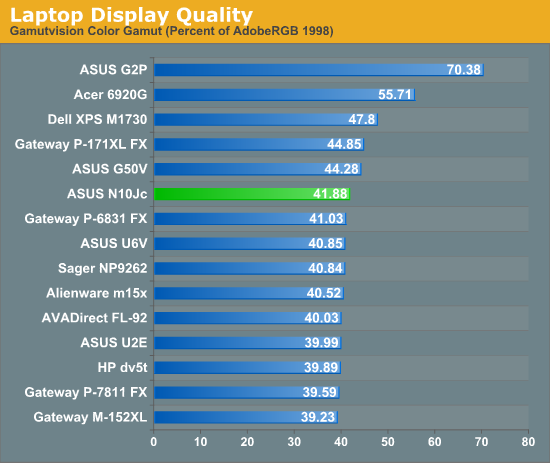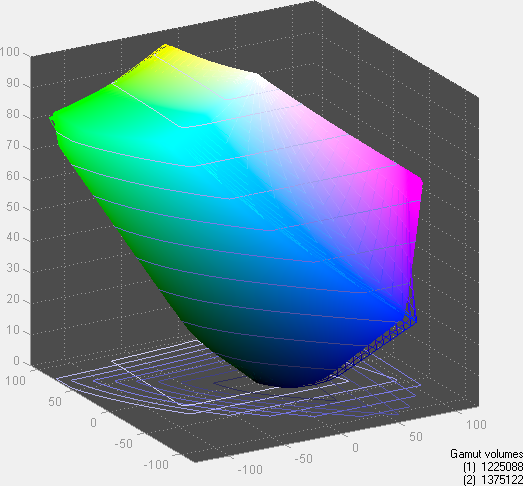Dell Studio XPS 16: Highest Color Gamut Ever?
by Jarred Walton on February 26, 2009 6:00 AM EST- Posted in
- Laptops
Okay, let's get something out of the way right off the bat: I started work on a review of the Dell studio XPS 16 before CES 2009. Originally intended to go live at CES, I decided to hold off in order to conduct additional testing and send some questions to Dell. Ultimately, we ran into some problems with the sample laptop, which is a prerelease version with a few kinks that need to be worked out. Ironically enough, the one major complaint in involves a glitch with the LCD on the unit we received, but we didn't notice this problem on any of the other studio XPS 16 laptops at the show. Anyway, I'm holding off on the full review until Dell can provide a retail sample, which should occur in the near future. In the meantime, one of the initial test results was shocking enough that I felt it was time for a blog. That's right: it's time to talk about laptop LCDs again!
When Dell claimed that the Studio XPS 16 would have the highest color gamut of any current laptop, I was a bit skeptical. I mean, the best color gamut I've seen up to now was on the ASUS G2P, which managed a rather impressive 70% of the Adobe RGB 1998 gamut. The next best LCD I've tested happens to be the Acer 6920G 1080P model, coming in around 55%. Everything else is roughly 45% or lower. On their own, such numbers don't necessarily mean a lot, so let's give a point of reference. Desktop LCDs from several years ago typically scored around 70% to 75% -- in other words the best laptop LCD I've tested to date might be able to match the entry-level desktop LCDs.
Here are a couple charts from the most recent reviews for laptops and LCDs showing how things stack up. To say that the laptop LCDs are uninspiring is a gross understatement.


As you might have guessed, the reason for this blog is that I was just putting together the results from the Dell Studio XPS 16. Given that it has a 16" LCD with a 1080P resolution, I assumed Dell was using the same LCD panel as the Acer 6920G. It's worth noting that there are two LCD models for the Studio XPS 16, so perhaps the less expensive version is the same as the Acer laptop. As for the more expensive LCD... well, have a look at the following color gamut chart (courtesy of Gamutvision).

It's not just that Dell has managed to close the gap with desktop LCDs; they have actually surpassed what many of the best desktop LCDs achieve! A color gamut of 112% of the Adobe RGB 1998 standard is extremely impressive. The "secret sauce" in this recipe for success is that Dell uses RGB LED backlighting instead of the standard white or yellow LEDs (or CCFLs) found in most LCDs. Obviously desktop LCDs have managed better color gamuts prior to now, but this is the first LED backlit LCD I've seen that actually manages to provide a good color gamut. That bodes well for the future of both desktop and laptop LCDs based on LED backlighting -- good colors and lower power requirements all in the same package.
Unfortunately, there are still some major gaps between desktop and laptop LCDs. The biggest one is the native panel technology; I still haven't managed to procure any laptops that use something other than a standard TN (twisted nematic) panel. That's entry-level desktop LCD technology, and while it's certainly cheaper, I prefer to spend the money on S-PVA, S-MVA, or S-IPS panels (in that order). Frankly, I would love to see any of those technologies utilized in a laptop LCD! (On a side note, if you get a desktop LCD and you plan to use it in portrait mode, you absolutely do not want a TN panel!) Panel technology also has a big influence on color quality, and so far none of the laptops I've tested come anywhere near what we see on a good desktop LCD. There are always spikes in delta E up to 5.0 or higher, and the Studio XPS 16 doesn't appear to change that.
Let's wrap things up with a little bit of polling, shall we? I have my opinions on how important a good LCD is when it comes time to purchase a new laptop, but I'm curious to hear your feelings on the subject. Let's not restrict things to just discussing LCD quality, though; I've put together several questions regarding LCDs. I'd love to hear your input, and if you have any other thoughts on the matter you can post below in the comments or drop me an e-mail.
{poll 121:1725}










91 Comments
View All Comments
oymd - Thursday, February 26, 2009 - link
Nice read...Is there any possibility of rating the Macbook Pro's screen as well? The 2008- ones, with LED backlights?
They r 15.4, 1440x900, and quiet a joy to work with. I wonder where would they be on your list of laptop LCDs?
Thanks
oymd - Thursday, February 26, 2009 - link
Oh...I meant the aluminum ones, not the new black framed ones...guess they are the 2007- modelsJorgisven - Thursday, February 26, 2009 - link
I'd agree, but the only time I even appreciate the extra pixels is in gaming. 1440x900 seems fine to me for normal web browsing and documents, but for gaming, the issue is that the graphic technology for laptops lags behind that of desktops. Trying to crank out 1920 res on an integrated chip usually results in abysmal performance, and gaming performance is more important to me. I realize laptops are not necessarily the best candidates for gaming though...Also, when cranking that much power to an LCD and optical drive, watching a Blu-Ray is sometimes out of the question on any battery older than a year or two. This isn't an issue yet, because laptop blu-ray hasn't been out long enough. Hopefully, this issue will get addressed by OEM's in the near future. Apple already has their 8-hour battery rolling out with a high-res screen, but neglects to offer a Blu-Ray player.
Ryan Smith - Thursday, February 26, 2009 - link
Honestly, I'm not sure how people deal with such ridiculously high pixel pitches on laptop monitors. I have perfect vision and anything below .2mm (such as a 1920x1200 panel in a 15" laptop) is an absolute bear to work with unless my nose is up to the panel. Even adjusting DPI doesn't go far enough in Vista (although it's better in OS X).I'd just as much rather see reasonable resolutions on high quality LCDs on laptops, rather than this insane push for 1080+ resolutions and the resulting subpar panels on screens little more than a foot big. The XPS 16 does seem to be an outlier in this respect, though.
JarredWalton - Thursday, February 26, 2009 - link
I think part of it has to do with the intended use. I have a 30" LCD, and I find the default text size too small at 2560x1600. I routinely bump up the "magnification" in Firefox and Word. However, a 1920x1200 15.4" LCD is no worse and probably a bit better in terms of comfort. That's largely because I sit 2-3 feet from my 30" LCD and only half that with a laptop. I totally agree that MS needs to make the DPI setting more useful, but sadly that has a lot to do with all the applications that do things their own way.FWIW, I don't think most of the higher DPI panels are subpar; usually it's the opposite, with slightly higher than average results. Really, I don't think *all* laptops need an awesome LCD, but it would be great to have more choice in the matter. Dell offers the RGB LED backlighting as a $50 upsell, and I think it's well worth the money.
crimson117 - Thursday, February 26, 2009 - link
Looks like a http://lt.dell.com/lt/lt.aspx?CID=27399&LID=62...">$250 upsell...JarredWalton - Thursday, February 26, 2009 - link
I was told $50 at CES, but then that was supposed to be going from a standard 1080P to the high color gamut 1080P. Now they've dropped the other 1080P it seems, so the $250 is for resolution as well as color. Oh well.GaryJohnson - Thursday, February 26, 2009 - link
Speaking of MS's DPI settings:[Rant]What the heck happened to the totally scalable vector-based GUI that was talked about pre-Vista? I've heard no mention of it in 7 either.[/Rant]
Spivonious - Thursday, February 26, 2009 - link
It's called WPF. We're starting to see more apps use it, but it won't get widespread adoption until we can get rid of all of those pre-XP machines, as it requires .NET 3.0 or higher.JarredWalton - Thursday, February 26, 2009 - link
LOL... and I thought I was the only one who noticed. ;-)I remember seeing a demonstration of a few applications, like Minesweeper and Calculator, and at least Minesweeper uses some method of scaling the app nicely. Unfortunately, none of the major applications work right.
On a related note, MS Word also seems to have some real issues scrolling properly when you use the internal magnification and a web page layout (which is what I always use when writing articles). It's a bug that has been present since at least Word XP.